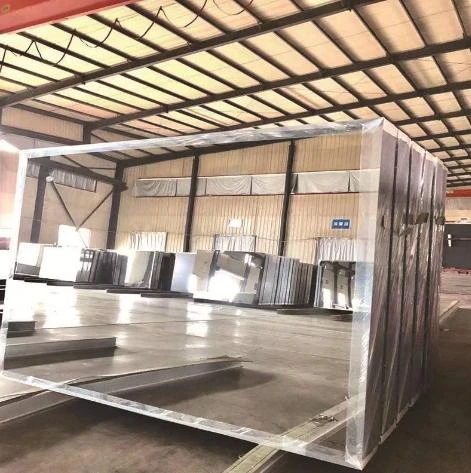Understanding Architectural Glazing A Key Element in Modern Design
Architectural glazing refers to the use of glass in the construction and design of buildings, an integral component that influences both aesthetics and functionality. It encompasses a wide variety of applications, including windows, facades, skylights, and curtain walls. As a pivotal aspect of modern architecture, architectural glazing has evolved significantly, informed by advancements in technology, materials, and design trends.
One of the primary functions of architectural glazing is to provide natural light to interior spaces. This aspect is crucial, as natural light has been shown to enhance well-being and productivity. By employing large glass panels and innovative designs, architects can create open and airy environments that foster a connection between indoor and outdoor spaces. It allows for expansive views and can dramatically improve the mood and atmosphere within a building.
Understanding Architectural Glazing A Key Element in Modern Design
In addition to energy efficiency, architectural glazing offers noise reduction and enhanced safety features. Double or triple-glazed windows, for example, can significantly diminish outside noise, creating a more serene indoor environment. Furthermore, advancements in glass technology have led to the development of impact-resistant and laminated glass, which enhance the safety and security of buildings. This is particularly relevant in urban environments or regions where extreme weather may pose risks.
what is architectural glazing
From an aesthetic standpoint, architectural glazing provides architects with a versatile tool to express creativity and style. The use of glass can transform a building's façade into a modern statement or harmoniously blend it with its surroundings. Various finishes, tints, and textures can be applied to glass to achieve specific visual effects, allowing for an array of design possibilities. Furthermore, the integration of glass into a structure's design can symbolize transparency and openness, aligning with contemporary values of accessibility and inclusivity.
However, the implementation of architectural glazing is not without its challenges. The initial costs can be higher than traditional building materials, and the weight of large glass panels requires careful structural consideration. Additionally, managing solar heat gain and glare is essential to ensure occupant comfort and energy efficiency. Architects and builders must collaborate closely to strike a balance between beauty and practicality, taking into account environmental factors and building usage.
Looking ahead, the future of architectural glazing appears bright. Ongoing advancements in smart glass technology, which allows for dynamic control over transparency and solar gain, hint at a new frontier for building designs. These innovations not only enhance comfort but also contribute to energy efficiency and sustainability. As cities continue to evolve and expand, architectural glazing will remain a fundamental element in shaping the built environment.
In conclusion, architectural glazing represents a critical intersection of art, science, and technology in modern architecture. Its ability to enhance natural light, promote energy efficiency, improve safety, and provide aesthetic appeal makes it indispensable in contemporary building design. As architectural trends continue to evolve, the role of glazing will undoubtedly grow, offering even more innovative solutions to meet the ever-changing needs of our urban landscapes. Embracing these advancements will ensure that architectural glazing remains a vital component in the future of sustainable and beautiful architecture.
 Afrikaans
Afrikaans  Albanian
Albanian  Amharic
Amharic  Arabic
Arabic  Armenian
Armenian  Azerbaijani
Azerbaijani  Basque
Basque  Belarusian
Belarusian  Bengali
Bengali  Bosnian
Bosnian  Bulgarian
Bulgarian  Catalan
Catalan  Cebuano
Cebuano  Corsican
Corsican  Croatian
Croatian  Czech
Czech  Danish
Danish  Dutch
Dutch  English
English  Esperanto
Esperanto  Estonian
Estonian  Finnish
Finnish  French
French  Frisian
Frisian  Galician
Galician  Georgian
Georgian  German
German  Greek
Greek  Gujarati
Gujarati  Haitian Creole
Haitian Creole  hausa
hausa  hawaiian
hawaiian  Hebrew
Hebrew  Hindi
Hindi  Miao
Miao  Hungarian
Hungarian  Icelandic
Icelandic  igbo
igbo  Indonesian
Indonesian  irish
irish  Italian
Italian  Japanese
Japanese  Javanese
Javanese  Kannada
Kannada  kazakh
kazakh  Khmer
Khmer  Rwandese
Rwandese  Korean
Korean  Kurdish
Kurdish  Kyrgyz
Kyrgyz  Lao
Lao  Latin
Latin  Latvian
Latvian  Lithuanian
Lithuanian  Luxembourgish
Luxembourgish  Macedonian
Macedonian  Malgashi
Malgashi  Malay
Malay  Malayalam
Malayalam  Maltese
Maltese  Maori
Maori  Marathi
Marathi  Mongolian
Mongolian  Myanmar
Myanmar  Nepali
Nepali  Norwegian
Norwegian  Norwegian
Norwegian  Occitan
Occitan  Pashto
Pashto  Persian
Persian  Polish
Polish  Portuguese
Portuguese  Punjabi
Punjabi  Romanian
Romanian  Russian
Russian  Samoan
Samoan  Scottish Gaelic
Scottish Gaelic  Serbian
Serbian  Sesotho
Sesotho  Shona
Shona  Sindhi
Sindhi  Sinhala
Sinhala  Slovak
Slovak  Slovenian
Slovenian  Somali
Somali  Spanish
Spanish  Sundanese
Sundanese  Swahili
Swahili  Swedish
Swedish  Tagalog
Tagalog  Tajik
Tajik  Tamil
Tamil  Tatar
Tatar  Telugu
Telugu  Thai
Thai  Turkish
Turkish  Turkmen
Turkmen  Ukrainian
Ukrainian  Urdu
Urdu  Uighur
Uighur  Uzbek
Uzbek  Vietnamese
Vietnamese  Welsh
Welsh  Bantu
Bantu  Yiddish
Yiddish  Yoruba
Yoruba  Zulu
Zulu 

